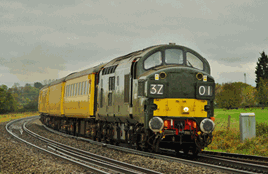Recycling is encouraged in the 21st century - and that seems to be the case on the railway, too. The freight industry has been buying locomotives from preservation and scrap merchants in recent months and years as more contracts are won requiring locomotives sooner rather than later.
It’s 20 years since Wisconsin Central arrived in the UK, buying three of the five pre-privatisation companies set up (Loadhaul, Mainline Freight and Transrail) as well as the parcel and charter operator Rail Express Systems.
Within six months, the newly-established English Welsh & Scottish Railway had also bought Railfreight Distribution(RfD) and placed an order for 250 Class 66s.
The future for the older traction fleets including Class 31s, ‘33s’, ‘37s’, ‘47s’ and ‘73s’ looked bleak, and that of the more modern ‘56s’, ‘58s’ and ‘60s’ was also up in the air. EWS followed up the order for the Class 66s with an order for 30 Class 67s. Even the electric fleet was not safe as Class 86s were withdrawn and ‘90s’ eventually stored.
Locomotives began to be made available, and while some were preserved in the early days, EWS set about a controversial policy of scrapping locomotives at Wigan Component Recovery and Distribution Centre (CRDC) at the former Spring’s Branch depot rather than make them available for sale.
This was challenged successfully, with the then rail regulator John Swift QC ruling that assets had to be disposed of.
This enabled companies such as Fragonset Railways and Direct Rail Services (DRS) to buy and restore locomotives deemed surplus by EWS but that would help these fledgling companies. Soon they would form the backbone of these fleets, and even in 2015 some companies such as Harry Needle Railroad Company (HNRC) and UK Rail Leasing (UKRL) rely on locomotives discarded in the late-1990s and early-2000s to build business and support major companies such as Colas Rail and GB Railfreight.
One of the most prolific traders is Harry Needle, who owns HNRC. His business model involves identifying markets and then searching for locomotives that will be suitable. Over the years this has enabled him to supply shunting locomotives to various companies and Class 20s for other industrial purposes.
Over the years he has also supplied Class 37s and 47s to DRS, but that market has dried up. Never one to miss an opportunity, Needle has been able to work closely with GB Railfreight (GBRf) and, latterly, Colas Rail. This has meant he has entered the loan market, hiring Class 47s from Riviera Trains (RT) and subsequently supplying them to GBRf.
These Class 47s were, largely, to be found at Crewe Diesel Maintenance Depot. Apart from one, the ‘47s’ were usually used for carriage heating at Crewe DMD and that was it. They had been removed from front line passenger duties by RT while other work had dried up. Occasional hire duties was all they were used for but they were still serviceable.
With GBRf requiring locomotives as it continued to win new contracts across the UK, the freight operator identified opportunities where older fleets could release more modern Class 66/7s for use elsewhere. This method had previously worked for short periods with a preserved Class 55, but the hire of ‘47s’ was on a more long-term basis.
They are based in Yorkshire and, following a major exam at HNRC’s Barrow Hill depot, they entered traffic with HNRC staff supporting them. The ‘47s’ haul sand trains from Doncaster to Goole, as well as gypsum trains in the area. This releases ‘66s’ for duties elsewhere. The versatility of the veteran Type 4s was shown in the summer when two were sent to Scotland to haul empty coaching stock moves for Caledonian Sleeper (CS). However, as reliability affected the CS fleet, so the ‘47s’ were used on portions between Edinburgh and Carstairs.
Of those that were returned to traffic on a regular basis, the oldest is 47815 Great Western. The Type 4 was delivered new as D1748 on July 1 1964 and is the oldest surviving main line-certified Class 47, delivered less than 24 months after the pioneer in September 1962. Indeed, of the five RT ‘47s’ used by GBRf the youngest is 47812, which was delivered on November 18 1965, meaning even that is half a century old.
But the ‘47s’ are not the only resurrected fleets GBRf has brought back to use. Class 73s are seen as the future for the company. This is a long-way from the turn of the millennium when the class seemed doomed, and GB Railways was handed a number of locomotives it seemingly didn’t want and which it stored at Norwich Crown Point.
Now GBRf cannot get enough of them. It has scoured the private market buying examples from preservation (73005/006, 73128) or from other main line operators (73107/109, 73201). 73119 Borough of Eastleigh was bought from Knights Rail Services, while 73103/105/117/134 were all bought from Nemesis Rail.
















Login to comment
Comments
FrankH - 25/02/2016 03:51
I'm surprised no freight operator took an option to to buy any of the refurbished class 86 and 87's that went to Europe. The Wembley Euro Freight centre - Daventry - Coatbridge/Mossend route would've been ideal for them. It's a pity the 92's rotting at Crewe arn't in anyones minds, 1 of those = a 1600 ton train over shap and beatock vs 2 66's or 2 86's/90's. DB reckons they're a lot more expensive to run vs a 90 which may be why they've stopped using them, or is it because they now have spare 90's having lost the CS sleeper contract.